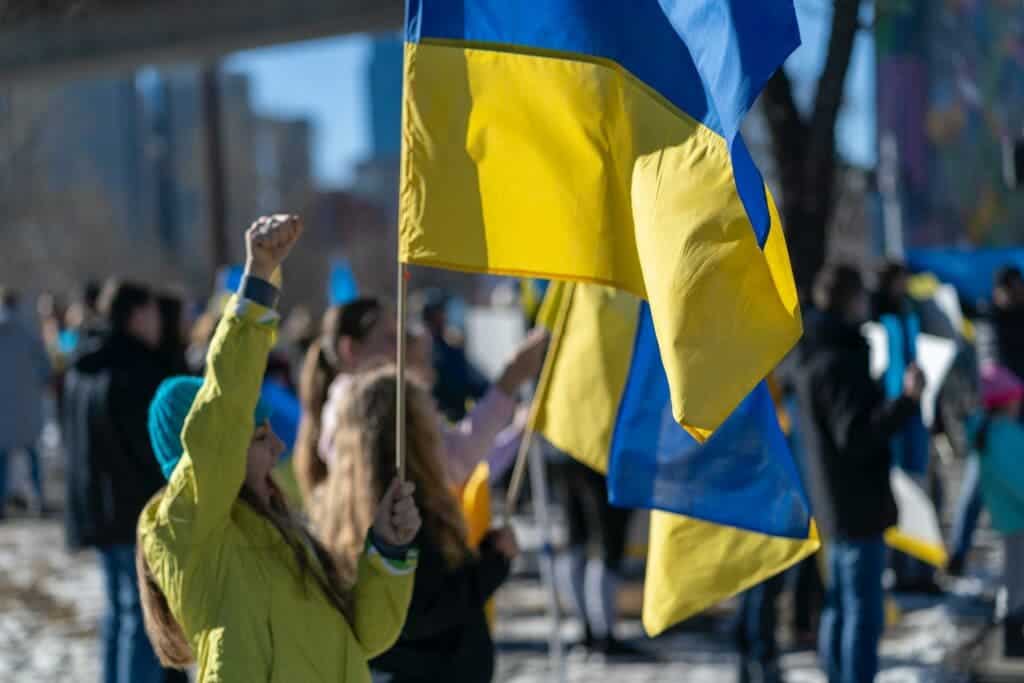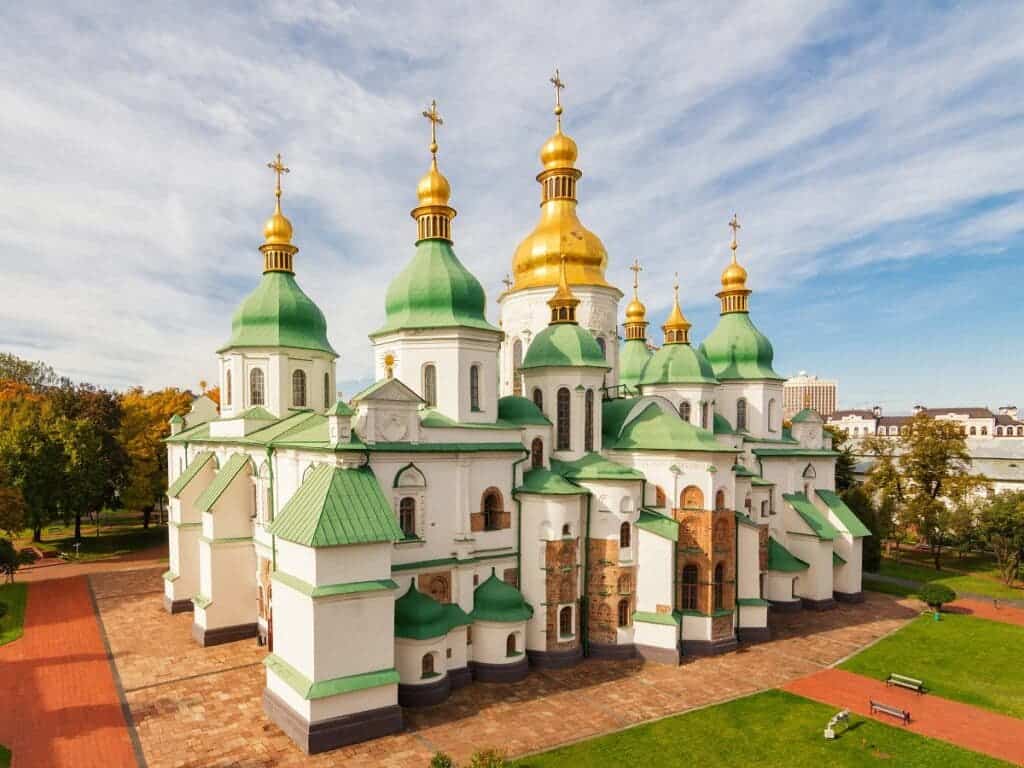While Ukraine is a well-known exporter of key products such as grains and steel, the country is also an important hub of art and heritage. It is home to seven UNESCO world heritage sites, hundreds of incredible monuments, historical landmarks, and millions of rare paintings and artworks. Much of this human heritage is currently on the verge of being destroyed due to the ongoing Russian invasion.

“We are facing not just an attack on Ukraine but an attack on our culture,” said Olesia Ostrovska-Liuta in an interview with the BBC when asked about the ongoing situation in her country. She is the director at Mystetskyi Arsenal National Art and Culture Museum in Kyiv which is ranked among Europe’s largest and most prestigious art museums.
With a heavy heart, Olesia reveals that currently, “the situation for museums and cultural institutions is no different from hospitals, schools, and residential areas: they are all under shelling”. As the whole country and its people are faced with an existential threat, the fight for Ukrainian art and heritage is on.
Why is Ukrainian culture being attacked?
Experts believe that attacking Ukraine’s art and heritage is actually Russia’s way of overtaking Ukrainian society and erasing its history. Essentially, Russia’s goal is to destroy Ukraine completely and keep it as a satellite state within its sphere of influence — the state press agency said as much when it mistakenly published an article about solving “the Ukrainian question”. To do so, it must not only destroy Ukraine’s cities, but also its heritage.
In part, Russia is already succeeding.
Recently, 25 paintings of legendary Ukrainian folk art painter Maria Prymachenko were reportedly burnt in an attack on the Kyiv-based Ivankiv museum. Prymachenko was no ordinary artist, she was a prominent figure in the field of Ukrainian folk art — so prominent that UNESCO had declared 2009 the year of Prymachenko in her honor.
Even great artist Pablo Picasso once said of Maria Prymachenko “I bow down before the artistic miracle of this brilliant Ukrainian.”
The loss of these artworks is substantial. Maria Prymachenko is an icon of Ukrainian national identity. Her brightly colored, playful, almost child-like artworks often feature blue and yellow (which are also on Ukraine’s flag), and while some of her paintings were saved from the fire by brave museum workers, it’s a huge loss.
It’s not clear yet how many Prymachenko pieces were destroyed, but it’s enough for the Ukrainian Minister of Culture, Olexandr Tkachenko, to request that Russia lose its UNESCO membership — the deliberate destruction of a country’s or culture’s heritage is considered a war crime, and yet surprisingly, UNESCO has not yet canceled its next summit scheduled to take place in Russia.
The works of other Ukrainian artists, such as Hanna Veres, were also lost, and since many civillian areas are shelled, the total toll is expected to increase. Ukrainian officials also fear that the Russian military will plunder and steal some of the Ukrainian artwork. The director of the National Museum of the History of Ukraine Fedir Androshchuk told The Guardian:
“There is no guarantee that the Ukrainian cultural heritage will not be plundered and transferred to Russian museums, especially given that Kyiv has a special place in Putin’s interpretation of Russian history and its roots.”

But Ukraine is not giving up, despite all odds. Whether it’s about protecting the capital city Kyiv or saving the symbols of their culture, the Ukrainian army, artists, authorities, and the public are leaving no stones unturned and showing great resilience and resolve.
When asked about his struggles of preserving the art amidst war, Androshchuk said that “You cannot force employees to come in and work under such circumstances. Many are fleeing with their families. But I am very proud of my colleagues. Many of them came to the museum and helped to dismantle the permanent exhibition.”
Olesia and Androshchuk are not the only people who are courageously making endeavors to protect their country’s heritage amidst war. From every corner of Ukraine, heroic stories are emerging of people protecting not just their country and loved ones, but also their heritage.
History under attack
In order to protect the truth about their history, temporarily moving collections to safe places in other countries is currently the best option for Ukraine’s museums, libraries, and art institutions. This is why the staff at such places is hard at work wrapping paintings, sculptors, and even monuments in plastic film, foams, and cardboard sheets so that all the historical artwork could be quickly moved to other places without any damage.
Luckily, one collection of over 1,000 objects was already shipped to a museum in Denmark for a temporary exhibition called Rus – Vikings in the East. Kyiv was an important Viking outpost and many see this period between 800 and 1050 C.E. as the start of their national identity.

Many Ukrainians view the period between 800 and 1050 C.E., when Kyiv was a Viking trading outpost (called Kønugarðr), as the beginning of their national identity — an interpretation that many Russians, including President Vladimir Putin, deny and want to destroy. These Viking artifacts are a testament that Ukraine will continue to have an independent historical identity no matter what happens.
Ihor Kohzan, the curator of Andrey Sheptytsky National Museum (one of the country’s largest museums on Ukrainian culture), also reveals that currently, various European institutes are also coming forward to help preserve his museum’s works and therefore, the museum is closed due to the war, but his staff is working hard inside to make the transfers possible.
However, the challenge for museum authorities and artists in Ukraine doesn’t end with making their collection ready to transport. Ukrainian art institutes require going through a lot of paperwork and government formalities before moving their collection to some other country. This could take weeks or more because, obviously, the government machinery already has a lot to deal with them being invaded by a foreign country.
Many institutes, including Kyiv’s Museum of Freedom, have already filed applications for the transfer. Still, they are not sure when they will get permission, so now they are employing other safety measures as well. Some of them are searching for safehouses within the country, and others are storing the artworks in metal containers and hiding them in basements and bunkers. According to the general director of the Museum of Freedom, Ihor Poshyvailo, the collection in their institute is “evidence of Ukraine’s fight for freedom,” so they are taking every possible measure to protect it.
“They hate our culture”
In most cases, though, it’s not possible to move the artworks and heritage pieces — and people are working on protecting them however they can. Apart from museums and art institutes, many nonprofits and locals have also come forward to offer help.
The windows of Kharkiv’s main art museum have been destroyed, exposing the over 25,000 artworks inside to freezing temperatures and snow for weeks. The city’s opera and ballet theaters were also extensively shelled.
In the western Ukrainian town of Lviv, workers are asking for things like heavy cardboard packing boxes, rolls of bubble wrap, plywood, and mounting foam to protect their art. Status are being covered in sandbags and stained glasses are being removed from churches. Here are just some of the Ukrainian efforts to save their culture amidst the ongoing Russian invasion.
Safeguarding buildings and monuments with protective material

Lviv is the sixth-largest city of Ukraine, and here locals and volunteers of the Lviv Foundation for the Preservation of Architectural and Historical Monuments can be seen placing hard cardboards on the glass windows of Dormition Church and other historically important buildings that were originally built between the 15th to 18th century.

Moreover, efforts are being made to shield the limestone statues of roman deities located outside and around the Latin Cathedral in Lviv. Since these 200 year old structured can not be moved, people have started wrapping these mini monuments in foam and plastic sheets with some help from the Lviv Foundation. The nonprofit said in a post, “We hope that this preventive action will not be tested by real explosions, but our hearts are glad that the vulnerable but valuable elements of this monument are protected.”
Jesus Christ is now safe inside a bunker
The Armenian cathedral in Lviv was built in 1363. Due to the war, the historical Jesus Christ statue located inside the cathedral has now been relocated to an unknown location for safety purposes. Previously, the statue was moved out during World War II.
Statues are covered with sandbags
The Monument to Duc de Richelieu is a historical landmark that was built to honor one of the pioneers of the modern city of Odessa. It is now surrounded by hundreds of sandbags like many other small and large monuments across the port city so that it could withstand the Russian attack.

The race to save Ukraine is on. As millions of Ukrainian families have lost their homes, and thousands of children are living as refugees, their is already facing an existential crisis. In these dire times, the heroic efforts made by people to save their country’s heritage and history are ensuring that Ukrainian heritage will never be lost. It’s a sense of hope that represents the undefeatable love that Ukrainians have in their hearts for their unique culture.


